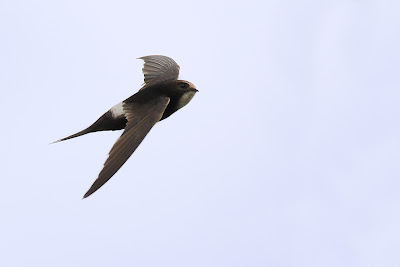White-rumped Swifts
I had walked past that tiny cave dozens of times, but that morning with some visitors, I ventured into its mouth. Perhaps there would be some bats and certainly the view across the dehesa woodland pasture was superb. The ground was still parched dusty-yellow, contrasting with the dark green forms of the holm oaks. We stood just inside the entrance and took in the scenery. Suddenly whoooosh! I was aware just of quite a large animal flying past our heads (we could feel the air move) and seemingly disappearing ahead of us. A split-second impression. Was it a bat? Well, it seemed a bit too big and I was sure that I had seen a flash of white. A minute or so later, it swept out again, also just a few centimetres from our heads and this time, although the view was almost as brief, it was obvious that it was a White-rumped Swift.
This is quite a mystery species. Its home is Africa, where it is widespread and common. It was first recorded in Spain in Cadiz province in the late 1960s and was initially misidentifed as Little Swift (which also occurs there), although the two species are actually quite different in appearance. As you can see from the excellent photo by Raymond de Smet, it has a bold white throat, a rather narrow white rump and quite a slender tail, with the fork often held closed, so that the tail looks pointed. It is somewhat smaller than a Common Swift. It was first recorded in Extremadura in 1979. It nests in old Red-rumped Swallow nests, under overhangs on rock faces and sometimes bridges. Whilst a scarce and localised species, it is undoubtedly under-recorded. No one knows how many pairs breed in Extremadura, but we guess at least 50 pairs and probably over a hundred.
To see White-rumped Swift, you need to be looking anytime from late April to early May (they are the latest of our four breeding swift species to arrive here) in rocky gorges or steep river valleys, where there are Red-rumped Swallows. Carefully checking any swift you see, keeping it in view as it twists and turns, waiting to see if the white band on the rump shows. There are often feeding parties of Common Swifts in these sites, so more times than not the swift turns out to be the all dark Common. But the interesting thing about the White-rumped Swifts is that they stay much later here, well into the autumn, long after the Common Swifts have migrated. My encounter in the cave was on 19th October, and the latest date ever recorded in Extremadura is 29th October. So any swift seen in October in such habitat is very likely to be White-rumped (apart from the much larger and differently patterned Alpine Swifts, a few individiuals of which also linger on into October).
Just five minutes after the swift had flown out, in it whooshed again, closely followed by another. This time we were prepared and watched their trajectory. They had in fact flown directly (and amazingly rapidly) up into their nest, just above our heads. An old Red-rumped Swallow nest, it showed the diagnostic little white down feather at its entrance, which for some reason the swifts place there. What was extraordinary to watch was the way they entered such a narrow rocky entrance and then up to the nest: we could see how they folded their wings to squeeze at full speed through the narrowest of gaps. Realising we were so close to the nest, where they probably still had young, we withdraw from the scene as quickly as possible, leaving them in peace. I had never dreamed of ever being as close as this to one of our most enigmatic species.




Comments